Everybody who's written a book likely has stories about all the weird and bizarre circumstances that led to its final incarnation on bookstore shelves. But if there's a crazier, more confusing story behind the publication of a book than the one involving Richard Laymon's second adult horror novel, The Woods Are Dark, I've not heard it.
Unless you're a Laymon fan, you probably haven't either. So strap yourselves in, hit up your favorite Dark Ambient playlist, and hold on to your butts -- it's about to get crazy in here. And because this is a deep dive, story spoilers are inevitable. You've been warned.
Note: all images in this article are scanned from my own sources.
The backstory behind The Woods Are Dark starts off simply. In 1980, Warner Books published Richard Laymon's first adult horror novel, The Cellar, as a paperback original. It looked like this:

That's a perfectly fine example of what you expect a horror book from 1980 to look like: black background, creepy cover artwork of a woman's hand opening an old door leading to a basement, title in large font, author's name much smaller, and a cover blurb from another, more established writer.
Flip it over, and again, about what you'd expect:
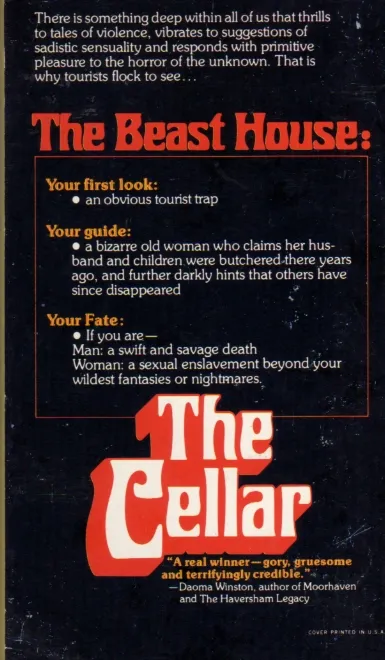
Don't worry, there's a reason I'm showing you the back cover. It'll make sense in a little while.
The Cellar, according to Laymon in his 1997 memoir, A Writer's Tale, was an unmitigated success. Warner made it one of their lead titles, throwing their considerable publishing weight behind it, and making only one significant change: Laymon's original title had been "Beast House", but with the recent release of the film Animal House, Warner wanted something that wouldn't make potential buyers associate it with comedy. The book's new title became The Cellar, and at Laymon's estimation, the Warner edition alone sold over a quarter of a million copies, and earned Laymon a further three-book contract with Warner.
Laymon submitted three other, already-finished, novels to Warner in the next few months, but for one reason or another, Warner rejected them all. They wanted something different, so he sent them a fourth completed story entitled The Woods Are Dark. In addition, Laymon sent the manuscript to some other horror writers he'd come to know, and returned with cover blurbs from no less than Gary (The Howling) Brandner and Dean Koontz, which he also passed to Warner.
Despite the virtually unrestrained creative freedom he'd enjoyed with The Cellar, and ringing endorsements from two respectable authors in the field, Warner didn't like what they read. Laymon's editor had some suggestions for changes, and Laymon, being a neophyte author, caved in and re-wrote the book to meet editorial approval. All told, around fifty pages of the original manuscript (and one entire major plotline) were cut, with new material written by Laymon to satisfy Warner's demands.
That's not a new story. Plenty of other horror writers, Jack Ketchum included, had it happen to them as well. It's what happened next that took the cake.
Laymon heard nothing from Warner until he received the proof sheets -- the typeset version that was headed for the printing presses -- and discovered, to his horror, that someone else at Warner had decided to do to his manuscript what the Krulls of the book did to their victims.
Whole paragraphs were missing. Scenes had been moved around, creating gaps or temporal distortions in the narrative. Sentences were cut, or added to, and the resultant cuts created errors in grammar, spelling, and punctuation. Words had been added to characters' dialog which Laymon had not penned.
Laymon was given a week to provide corrections, so he went through and fixed everything he could find. Warner received his corrections, then told him it was too late, the novel was already going to print, and his corrections would cost too much money to implement. Some forty mistakes, errors, and unauthorized re-writes made their way into The Woods Are Dark.
The only saving grace left to Laymon now was the knowledge that he'd seen the cover artwork, and felt there was a good chance it would be eye-catching enough to grab a reader's attention and result in decent sales, perhaps better even than The Cellar pulled in.
Then he saw the cover after Warner tampered with it:
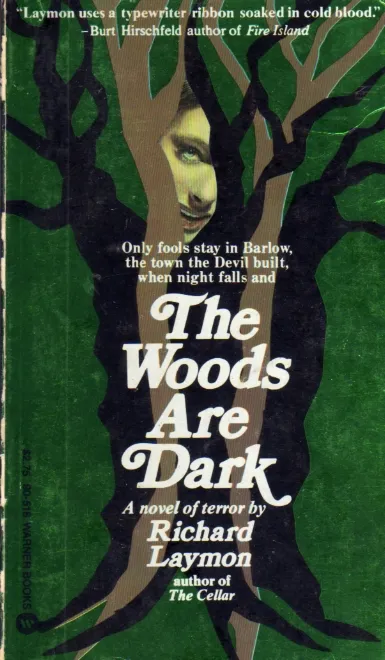
You can't tell from the scan, but all the green you see there isn't a matte color. It's shiny foil stamping, like what you'd expect as the cover enhancement of a 90's comic book. You might think there's not much wrong with it, that it looks kind of like a V.C. Andrews novel with a step-back cover. But that's only because you're not seeing the cover artwork as Laymon originally saw it. Well, except for that little peek of a woman's face between the branches.
And if that cover had been a step-back (a term describing a book with a main cover with a cut-out area, which can then be opened to reveal a secondary piece of artwork behind it), it might still have been OK. But the cover is a solid piece of paper. The real cover art, the planned piece of art Laymon had seen and assumed would be used to sell his book, was instead relegated to the back cover for some reason:
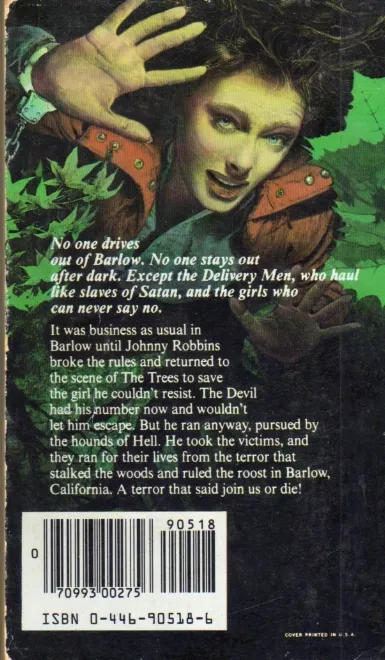
Not only had Warner put the front cover art on the back, but close examination reveals the woman is lying on the ground, with her hair splayed out across the soil, meaning Warner used the picture upside down. It should have looked like this:
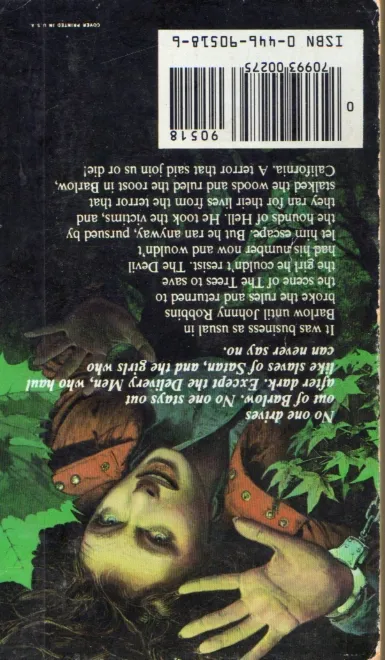
The other thing you may have noticed about the cover: it bears the same blurb from The Cellar -- a blurb which, it turns out, was completely made up. Burt Hirschfeld never read either The Cellar or The Woods Are Dark; Laymon's agent at the time simply made the quote up himself, attributed it to Hirschfeld, and passed it off to Warner as legit. It's also missing either of the aforementioned actual cover blurbs Laymon procured from two actual, best-selling horror writers.
You know, a thing that drastically improves the odds of horror readers giving a book a chance.
While The Cellar flew off shelves the way Japanese express trains zip through the countryside, copies of The Woods Are Dark sat. And sat.
And sat.
It sold 70,000 copies thanks to that uninteresting cover and a story that quickly garnered a reputation for being nowhere near as interesting, or intense, as The Cellar. There were no subsequent printings.
The Warner edition clocked in at a total of forty chapters and 240 pages. (Keep these numbers in mind -- it will be important later).
If that's where things ended, I wouldn't be writing this post. A publisher destroyed a writer's career -- so what? Sucks, but it happens all the time. Well, hold on, because this is where stuff gets interesting. Over the UK, it was a totally different story.
Over in the UK, in 1991, they got this:

I'm sorry, but fuck yes, now that is an attention-grabber! Steve Crisp was responsible for nearly all the cover artwork for the Headline paperback editions of Laymon's UK novels, and for every single one, he knocked it out of the park. What's more, that's an actual scene straight out of the book: the cluster of dead trees where the townsfolk of Barlow take their victims to be harvested by the Krulls.
It doesn't stop there either. Notice the blurb from Dean Koontz, the one Warner was apparently to stupid to use, right up there at the top? Yup, the UK version of Woods got that. And if we check the back cover...
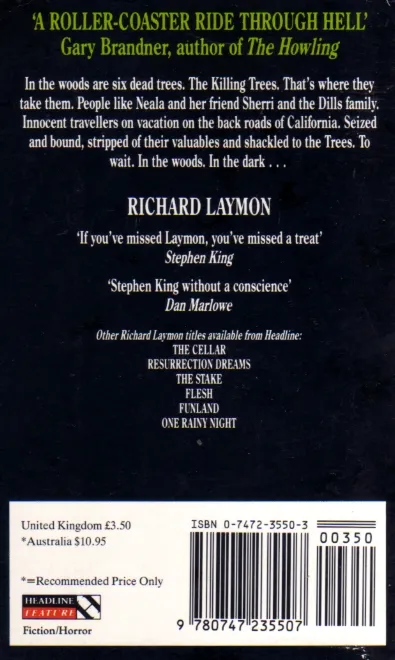
...why, look at that: Gary Brandner's blurb lives as well, not to mention some other writers who were just as excited about Laymon's work as Koontz and Brandner were. It's almost like Headline had an interest in selling this book to as many people as possible, and were succeeding. By 1997, it was on its 11th printing.
What's even more interesting about this UK edition is that while it's still based on the Warner manuscript, it contains all of the fixes Laymon performed which Warner refused to implement. While this doesn't do much to improve the story overall, it's at least not as hacked up as the original US edition.
The Headline UK edition pictured here runs for forty-one chapters and 247 pages which, you will note if you're keeping track, is one chapter and seven pages longer than Warner's version -- not terribly substantial, but a cumulatively notable difference nonetheless.
But what, if anything, happened to Laymon's original manuscript, the one he gave to Koontz and Brandner to read, the one Warner rejected before Laymon edited it to their specifications? Jack Ketchum at least got the opportunity to re-write Off Season with the ending he'd originally planned. Could Laymon do the same?
Therein lies an entirely new chapter of the tale, where the answer was both 'no'...and 'yes'.
Richard Laymon died in 2001, at the age of 54. Unfortunately, prior to that, he'd never had the opportunity to get the "right" version, his version, of The Woods Are Dark into readers' hands. And, in fact, he never thought he could resurrect that version. Laymon remarked on more than one occasion that the original manuscript no longer existed intact. The excised chapters were later compiled and published as stand-alone curiosities in a chapbook, but this was Laymon's Humpty Dumpty. All the king's horses, yadda yadda...
But while Richard Laymon might have held that to be gospel truth, his daughter Kelly did not. And while it took her half a dozen years of digging through her dad's archives, including one handwritten draft of the novel, manage it she finally did. The result was that in 2008, Leisure published this edition:
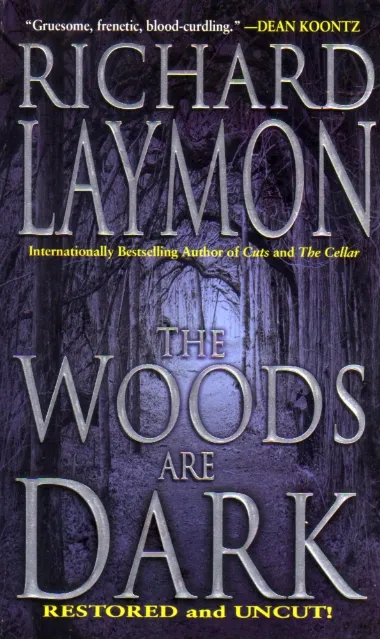
And, just so we keep the tradition going, here's the back cover:
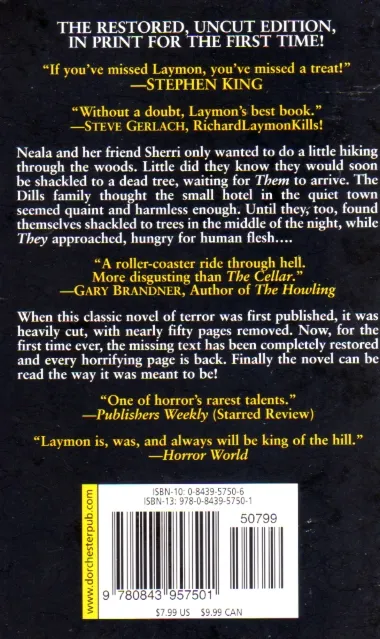
Perhaps most surprising is that the Restored and Uncut edition of The Woods Are Dark runs for 37 chapters and 1 epilogue, over 215 pages.
Wait, What?!
No, that's not a mistake. Actually, since the first five pages of this edition consist of Kelly Laymon's notes about the project, the story itself takes up only 210 pages. How, with the Warner and Headline UK editions lacking fifty pages of content, does the original manuscript clock in at two fewer chapters and thirty fewer pages?
Well, remember, Laymon didn't just cut fifty pages from his story and call it a day, he also added things to cover the requested changes. Plus, Warner's line editor performed additional surgery on Laymon's manuscript, adding words and dialog which Laymon himself never penned, including a reference to McDonalds which pops up in the third paragraph of the Warner manuscript but is absent from Laymon's original, meaning Warner started their hatchet work on literally the first page.
The major change made by Laymon to the Warner edition included expanded development on the townsfolk of Barlow. These changes mainly come from an entirely new story thread about two characters, Peggy and her daughter Jenny, who learn about Johnny's betrayal of the Krulls and try to escape Barlow before the town finds out what he's done and executes them as a lesson to other townsfolk not to take a shine to outsiders.
In order to include this storyline, Laymon cut part of the plot concerning the Dills family, who wind up in Barlow after dark and are given over to the Krulls. Cordelia Dills and her boyfriend, Ben, remain in the Warner edition, while the plot dealing with Lander and Ruth Dills, Cordelia's father and mother, is excised. In the Warner edition, Lander only returns at the very end of the narrative, unnamed and butchered by the Krulls as a sacrifice, with Ruth having been killed and cannibalized off-screen.
In the Restored and Uncut version, there is no Peggy and Jenny storyline, and much of the back-story information about the townsfolk of Barlow doesn't exist. Instead, we see what happens to Lander and Ruth as they're attacked by the Krulls. Ruth is still butchered, but Lander escapes. In fact, Lander doesn't just escape from the Krulls, he goes full-on feral, descending into madness and giving into the beast which has always resided within him, but which civilization has kept entrapped all these years.
Lander's chapters are among the bloodiest, most sexually explicit, and horrifying scenes of the whole narrative, as he wages a one-man war on the Krulls, killing and raping with abandon, slowly losing his sanity. While he's dead by the conclusion of the Warner edition, Lander Dills is very much alive at the end of the uncut edition, a fact which Laymon underscores perfectly in the now-present epilogue.
Also different -- vastly different -- is the ending itself. In the Warner manuscript, the Krulls commit their acts of atrocity and cannibalism in service to a much higher power: a Lovecraftian nightmare of tentacles and radiation which resides in a pit near the killing trees. So long as it's regularly fed with the bones of the Krulls' victims, this monstrosity is content to remain in its hole. The Krulls, and the residents of Barlow themselves, while engaged in wholesale slaughter and brutality, do it out of a sense not just of self-preservation but world-preservation. Should the being in the pit decide to leave, the havoc it would cause is unimaginable. The book ends abruptly, with several characters getting to a vehicle just in the nick of time and high-tailing it out of Barlow as the creature emerges from its hole, slaughtering everything in its path.
But there's no mention of this creature at all in Laymon's original manuscript. The story ends in a much more realistic (if you can call a story about cannibal tribes living in the forests of California "realistic") fashion: no nightmares from beyond space, no black writhing tentacles. And different outcomes for Sherri, Lander, Cordelia, Johnny, Neala, and Lilly.
So, The Woods Are Dark is truly an oddity among Laymon's body of work. Of everything he wrote, it's one of only two novels where vastly different versions exist due to editorial interference (the other is Resurrection Dreams, which I'll dive into once I get my hands on a copy of the UK edition).
Of the various editions, the Restored and Uncut edition published by Leisure is far and away the better story. While the bits Laymon wrote for the Warner edition, which explain the town's backstory and give us the POV characters of Jenny and Peggy, aren't bad and contain a few brutal moments (Jenny, especially, is quite the little sociopath), the Lander Dills chapters they replaced are far more interesting, exciting, and gut-wrenching. We care about the Dills family, who wandered into this nightmare unaware of what they were getting into. Peggy and Jenny, by contrast, have lived in the town their whole lives and are well aware of the deal with the Krulls, making them far less sympathetic. The reworked ending, which just stops abruptly, is also far weaker than Laymon's original, which posits a continuation of the nightmare under very different circumstances.
That said, if you're determined to make the comparison yourself, I highly recommend getting the Headline UK paperback -- it's far cheaper and easier to find than the Warner original, and it at least fixes the bulk of the errors introduced by Warner's machete work. Plus, the cover artwork is just better.
So, there you have it: the story behind The Woods Are Dark, the book which tanked Laymon's career in the US, the book which Laymon himself never thought could be brought to life, and the manuscript his daughter unearthed and patched together from her father's extensive files. If you're a fan of balls-to-the-wall cannibal action, similar in vein to Jack Ketchum's Off Season or Wes Craven's The Hills Have Eyes, and you've yet to dig into this one, reserve some room on your next plate.
It's a doozy.
